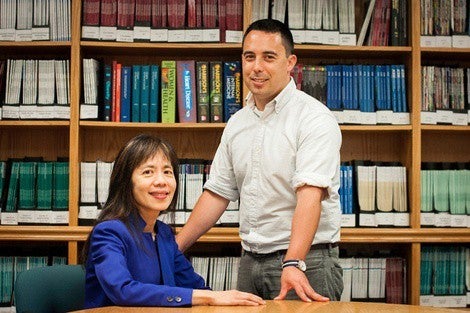July 11, 2013 — In the 1960s, the late epidemiologist Ralph Paffenbarger, Jr. launched a study of men matriculating as undergraduates at Harvard University that would be among the first to link physical activity to a longer, healthier life. While teaching at Stanford in the 1980s, Paffenbarger’s enthusiasm for the work rubbed off on graduate student I-Min Lee, now professor in the Department of Epidemiology at HSPH, and led to a decades-long collaboration between the two researchers that has resulted in numerous studies.
Lee took over the reins of Paffenbarger’s still-ongoing College Alumni Health Study in the 1990s. Since then, she has broadened the scope of the department’s work in physical activity research. While Paffenbarger’s pioneering study only looked at men performing vigorous exercise, Lee studies both genders and has worked to assess the benefits of more moderate physical activities such as walking. Now, her doctoral student Eric Shiroma is carrying on the legacy — with the help of a research award named after Paffenbarger.
The Paffenbarger-Blair Fund for Epidemiological Research on Physical Activity, offered by the American College of Sports Medicine, awards $10,000 annually to a promising young researcher. Paffenbarger himself provided the seed funding, donating money he received as co-recipient of the first International Olympic Committee prize for sport science.
Paffenbarger, who remained an adjunct professor at HSPH until his death at age 84 in 2007, found that men who exercised vigorously, burning 2,000 calories a week, lived longer than those who didn’t. When naysayers questioned whether those extra years were worth the effort, the gentle yet tenacious researcher known as “Paff” to his colleagues observed that exercise not only “adds years to your life but life to your years.” His findings contributed to changes in federal health recommendations and helped lay the groundwork for the modern fitness movement.
Observing that it is healthier in the long run to take up exercising later in life than to be a college athlete turned couch potato, Paffenbarger became an avid long distance runner in his 40s. But the health benefits of a vigorous running habit may be a hard sell for those who are sedentary. Fortunately, Lee’s research has shown that moderate activity can also be beneficial.
In a study published earlier this year, Lee and her colleagues found that adults over 40 who walked briskly for 75 minutes each week — roughly 11 minutes a day —lived 1.8 years longer than those who didn’t exercise at all. Those who got the federally recommended minimum of 150 minutes of moderate exercise a week — 30 minutes every five days or 22 minutes every seven days — gained 3.4 years.
“What we found is really encouraging,” Lee told Harvard Magazine in an interview earlier this year. “If you do a little, you get a fairly good gain in years.” More may be necessary to avoid weight gain, she said, but aiming for some daily physical activity is a good place to start.
Lee and Shiroma are now working to provide evidence that can lead to recommendations for light physical activity. This has been difficult to assess in the past, Lee said, because study subjects have trouble accurately reporting the amount of time they spend doing light daily activities such as dusting or folding laundry.
New technology is helping to solve that problem. Accelerometers track a subject’s level of movement, whether they are out for a run or watching TV. But experts disagree about whether the devices should be worn at the waist or on the wrist. Subjects are more compliant when wearing wrist accelerometers, but the device may over-report movement for someone who talks with their hands, for example. Conversely, a device worn on the belt may not pick up some types of activity, such as weightlifting.
Shiroma is working to compare data collected from the two different placements of the device. An avid exerciser since taking up competitive swimming and martial arts at a young age, Shiroma also hopes to shine light on the potential benefits of including strength training in regular physical activity routines.
“I am honored to receive an award in Dr. Paffenbarger’s name, and look forward to furthering our understanding of the relationship between physical activity and health,” Shiroma said.
Photo: Aubrey Calo
